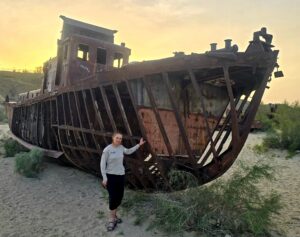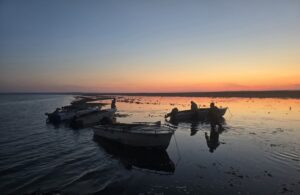Adventurer completes 9000km epic journey of Aral Sea and ancient Silk Roads with historic discovery
On August 16, in the United Na7ons International Year of Glaciers’ Preserva7on, Ms Leeming discovered the true source of the historic Oxus River (Amu Darya) in Afghanistan’s Wakhan Corridor at the conclusion of her 9001km, 149-day bicycle journey through Central Asia.
On 22nd March 2025, World Water Day, Ms Leeming began an epic 9,000km, five-month bicycle journey through the heart of Central Asia.

Her route followed the Syr Darya (Jaxartes River) from its source in the Tien Shan, Kyrgyzstan, to the Aral Sea, and from there traced the course of the mighty Amu Darya (Oxus River), concluding with a geographical “first,” the discovery of its true source at the glacial origin of Chelab Stream in the Liale Pamir, Wakhan Corridor, Afghanistan.
The journey took Ms Leeming through six countries, from the high Tien Shan, Pamir andHindu Kush mountains, the “water towers” of Central Asia, and across the steppes and scorching deserts, as she explored the ethnically diverse realm of the ancient Silk Roads.

Ms Leeming investigated the vital role of water and the consequences of its mismanagement, especially in relation to the Aral Sea Basin. She found that just as cycling connected her to thepeople and the lands of Central Asia, water flowing down its glacier-fed rivers connects every aspect of life.
Water from the Amu Darya, however, no longer reaches the Aral Sea largely due tomismanagement of the river systems. Since the 1960s, the Aral Sea South coast has receded 100km; now, barely 10 per cent of its water defies evapora7on. This is largely due to blatantover-produc7on of water-thirsty coaon and rice crops in the Soviet and post-Soviet eras,compounded by the effects of climate change.
Considered one of the worst man-made environmental disasters in history, toxic, saline dust causes severe health issues locally and has been detected as far away as Greenland’s ice cap and in the blood of Antarctica’s penguins. This catastrophe affects people and the environment on a global scale and serves as a warning to the rest of the world, of what can happen if we all don’t take better care of it.

Central Asia is the hub of the ancient Silk Route. It has been a crossroad of civilisations for millennia, where distinctive cultures have connected, mutually influencing each other. For the six nations that share the water resources of the Aral Sea Basin, managing and solving the water issues requires the same enduring legacy of the historic Silk Roads; cultural understanding, open dialogue, innovation and collaboration.
Travelling by bicycle gave Ms Leeming an intimate, grounded perspective of how the region fits together; the landscape and the local people – their history, cultures, the issues they face and their hopes for the future.

About Kate Leeming
As an explorer/adventurer Ms Leeming has cycled 106,000km, more than 2.5 X the Earth’s circumference and achieved several world firsts on her major expeditions: across Russia,25,000km + 8600km through Australia, 22,000km west to east across Africa, from Senegal toSomalia and 9000km through Central Asia. She’s also an educator, presenter, author, filmproducer and a real tennis professional. Her Australian and African expeditions were Official Activities for the UN Decade of Education for Sustainable Development. Ms Leeming’s most significant awards include an Honorary Doctor of Educa7on degree (The University of WesternAustralia, 2016), a Medal of the Order of Australia (OAM, 2023) and Australian Geographic’s prestigious Spirit of Adventure Award (2023).

Outcomes
Supporting water.org – helping bring safe drinking water and sanita7on to the world: Just $5(USD) provides someone with safe drinking water or access to sanitation, and every $5 donated to Kate’s fundraiser will enter the donor into the Breaking the Cycle Prize Draw.haps://give.water.org/f/breakingthecycle/#
TV series (A-OK Media House, 4×60 minutes)
Educa7on programme (EBTSOYP.com, The Duke of Edinburgh’s Interna7onal Award Australia,The Royal Geographical Society)
Central Asian countries
Kyrgyzstan, Uzbekistan, Kazakhstan, Turkmenistan, Tajikistan, Afghanistan
Historical importance of the source of the Oxus/Amu Darya
The true source of the Oxus River/Amu Darya has been a maaer of conjecture for at least 200years; since the Great Game when imperial Britain and Russia competed for control of Central Asia.
Created in the late nineteenth century at the conclusion of the Great Game, the WakhanCorridor served as a buffer between the territories of the Bri7sh and Russian empires. Thetwo empires agreed that the true source of the Oxus would mark the border between theirterritories. Several sources of the river were identifiedfied however the true source was never located.
In 2007, Bill Colegrave led an expedition in search of the true source of the Oxus andconcluded that it was the head of the Chelab, a stream flowing down from the Nicholas Range (Named a/er Tzar Nicholas II during the Great Game). Unusually the stream bifurcates; the west-flowing branch enters the Liale Pamir (or Bozai) River (which 15km later joins theWakhjir to become the Wakhan River), the east-flowing rivulet ends up in Lake Chakmak7n(out of which flows the Aksu/Murghab/Bartang tributary of the Oxus). This means waterfrom the Chelab flows into the two main tributaries of the Oxus/Amu Darya. Therefore, the source of the Chelab should be considered the true source of the mighty Oxus River.
However, while Bill Colegrave identifyfied the Chelab Stream as being the true source, he had onlybeen as far as where it bifurcates and encouraged Kate and her team (Rupert McCowan, Malang Darya and Adrian Dmoch) to follow the stream and its tributaries to discover the truesource of the Oxus/Amu Darya.
More informaHon
https://www.breakingthecycle.education/expeditions/breaking-the-cycle-central-asia/
Images for PR
https://www.dropbox.com/scl/fo/ydfb1wbftnymd2bwgeckc/AMSKflLGtyKOtqlz2xR1O-o?rlkey=a66unco2ummxw3e2h4vlhrelf&st=6ss4voy9&dl=0
Contact
+61 (0)429 77222